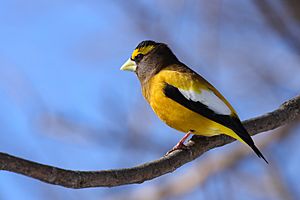Evening grosbeak facts for kids
Quick facts for kids Evening grosbeak |
|
|---|---|
 |
|
| Male evening grosbeak in Cap Tourmente National Wildlife Area, Quebec | |
| Conservation status | |
| Scientific classification | |
 |
|
| Range of H. vespertina Year-round range Wintering range | |
| Synonyms | |
|
Coccothraustes vespertinus |
The evening grosbeak (Hesperiphona vespertina) is a colorful bird found in North America. It belongs to the finch family, Fringillidae. These birds are known for their large, strong beaks. Their beaks help them crack open tough seeds. You can often spot them in forests. They might also visit bird feeders, especially during winter.
Contents
What's in a Name?
Scientists group living things to study them better. Birds are grouped into families and genera. The evening grosbeak and its close relative, the hooded grosbeak, are usually placed in the genus Hesperiphona. Some bird lists, however, group them with the hawfinch in the genus Coccothraustes.
The name Hesperiphona comes from Ancient Greece. Hesperos means "evening," and phone means "cry." The specific name vespertina is Latin for "evening." So, its name basically means "evening bird" or "evening cry."
What Do They Look Like?
The evening grosbeak looks a lot like the Eurasian hawfinch. Both are strong, chunky finches. They have big bills and short tails. An evening grosbeak is about 16 to 22 centimeters (6 to 9 inches) long. Its wings can spread 30 to 36 centimeters (12 to 14 inches) wide.
Male and female grosbeaks look different. Adult males have a bright yellow body and forehead. Their heads are brown, and they have a large white patch on their wings. Adult females are mostly olive-brown. Their undersides are grayer. They also have white patches on their wings.
These birds have a short black tail and black wings. Their large bill is usually pale.
Where Do They Live and What Do They Eat?
Evening grosbeaks live in coniferous and mixed forests. You can find them across Canada and in the western mountains of the United States and Mexico. They build their nests on horizontal tree branches or in a tree fork.
These birds often move around. Their migration patterns can change each year. In some winters, they might travel as far south as the southern U.S.
Evening grosbeaks find their food in trees and bushes. Sometimes, they also look for food on the ground. They mainly eat seeds, berries, and insects. Outside of the nesting season, they often feed in large groups. They might even swallow small pieces of gravel sometimes.
The area where these birds live has grown over time. This might be because more Manitoba maple trees and other shrubs have been planted. Also, bird feeders in winter provide them with extra food.
Gallery
-
Female evening grosbeak in Algonquin Provincial Park, Ontario, Canada
-
Male evening grosbeak in Truchas, New Mexico
-
Female in winter, Gatineau Park, Quebec, Canada
See also
 In Spanish: Pepitero norteño para niños
In Spanish: Pepitero norteño para niños






